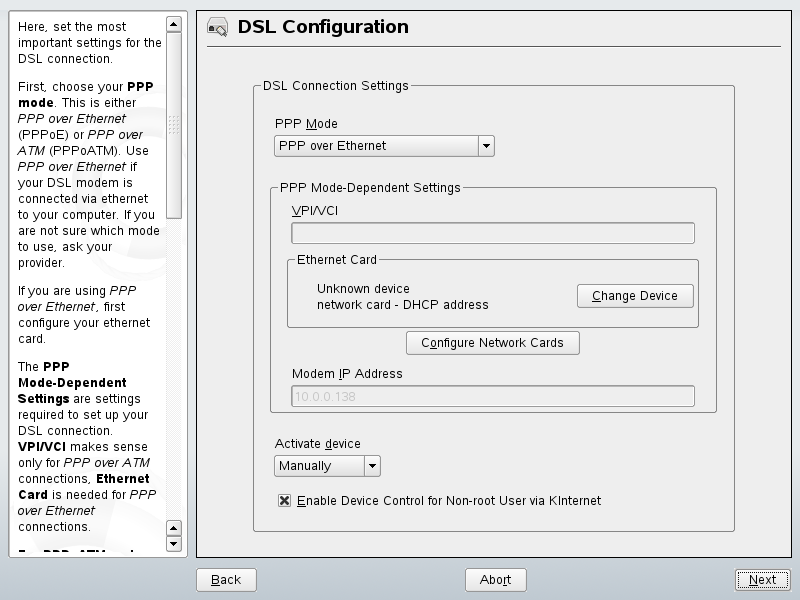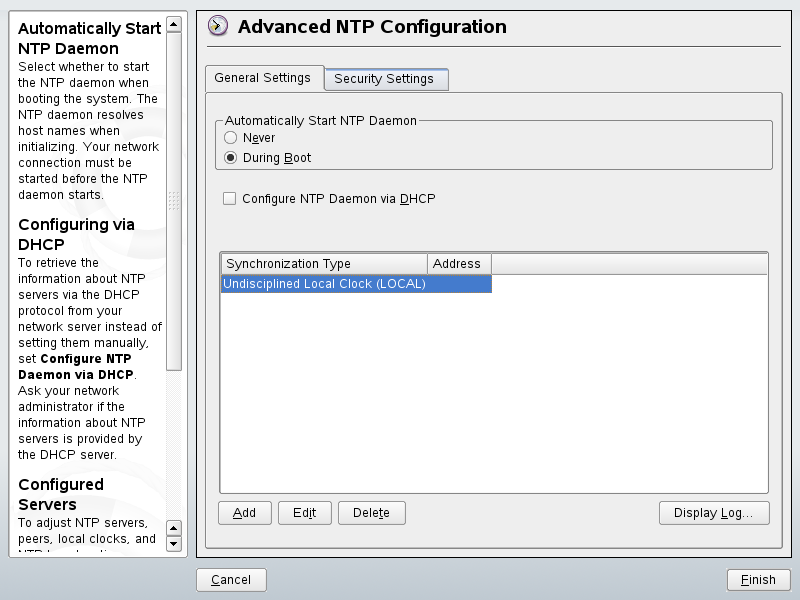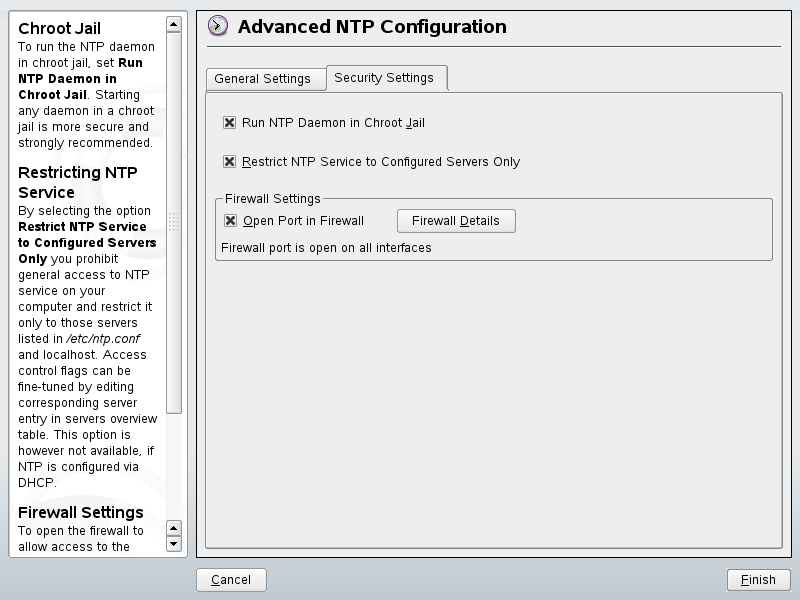24.1 Configuring an NTP Client with YaST
xntp is preset to use the local computer clock as a time reference. Using the (BIOS) clock, however, only serves as a fallback for the case that no time source of greater precision is available. YaST facilitates the configuration of an NTP client. For a system that is not running a firewall, use either the quick or advanced configuration. For a firewall-protected system, the advanced configuration can open the required ports in SuSEfirewall2.
24.1.1 Quick NTP Client Configuration
The quick NTP client configuration () consists of two dialogs. Set the start mode of xntpd and the server to query in the first dialog. To start xntpd automatically when the system is booted, click . Then specify the . Either click if you cannot use a local time server or click to access a second dialog in which to select a suitable time server for your network.
Figure 24-1 YaST: Configuring an NTP Client

In the detailed server selection dialog, determine whether to implement time synchronization using a time server from your local network () or an Internet-based time server that takes care of your time zone (). For a local time server, click to start an SLP query for available time servers in your network. Select the most suitable time server from the list of search results and exit the dialog with . For a public time server, select your country (time zone) and a suitable server from the list under then exit the dialog with . In the main dialog, test the availability of the selected server with and quit the dialog with .
24.1.2 Advanced NTP Client Configuration
The advanced configuration of an NTP client can be accessed under from the main dialog of the module, shown in Figure 24-1, after selecting the start-up mode as described in the quick configuration.
Figure 24-2 Advanced NTP Client Configuration: General Settings

On the tab, configure the mode of operation of xntpd. sets up the NTP client to get a list of the NTP servers available in your network via DHCP.
The servers and other time sources for the client to query are listed in the lower part. Modify this list as needed with , , and . provides the possibility to view the log files of your client.
Click to add a new source of time information. In the following dialog, select the type of source with which the time synchronization should be made. The following options are available:
- Server
-
Another dialog enables you to select an NTP server (as described in Section 24.1.1, Quick NTP Client Configuration). Activate to trigger the synchronization of the time information between the server and the client when the system is booted. allows you to specify additional options for xntpd.
Using , you can restrict the actions that the remote computer can perform with the daemon running on your computer. This field is enabled only after checking on the tab. The options correspond to the restrict clauses in /etc/ntp.conf. For example, nomodify notrap noquery disallows the server to modify NTP settings of your computer and to use the trap facility (a remote event logging feature) of your NTP daemon. Using these restrictions is recommended for servers out of your control (e.g., on the Internet).
Refer to /usr/share/doc/packages/xntp-doc (part of the xntp-doc package) for detailed information.
- Peer
-
A peer is a machine to which a symmetric relationship is established: it acts both as a time server and as a client. To use a peer in the same network instead of a server, enter the address of the system. The rest of the dialog is identical to the dialog.
- Radio Clock
-
To use a radio clock in your system for the time synchronization, enter the clock type, unit number, device name, and other options in this dialog. Click to fine-tune the driver. Detailed information about the operation of a local radio clock is available in /usr/share/doc/packages/xntp-doc/refclock.html.
- Outgoing Broadcast
-
Time information and queries can also be transmitted by broadcast in the network. In this dialog, enter the address to which such broadcasts should be sent. Do not activate broadcasting unless you have a reliable time source like a radio controlled clock.
- Incoming Broadcast
-
If you want your client to receive its information via broadcast, enter the address from which the respective packets should be accepted in this fields.
Figure 24-3 Advanced NTP Client Configuration: Security Settings

On the tab, determine whether xntpd should be started in a chroot jail. By default, is activated. This increases the security in the event of an attack over xntpd, because it prevents the attacker from compromising the entire system.
increases the security of your system by disallowing remote computers to view and modify NTP settings of your computer and to use the trap facility for remote event logging. Once enabled, these restrictions apply to all remote computers, unless you override the access control options for individual computers in the list of time sources on the tab. For all other remote computers, only querying for local time is allowed.
Enable if SuSEfirewall2 is active, which it is by default. If you leave the port closed, it is not possible to establish a connection to the time server.